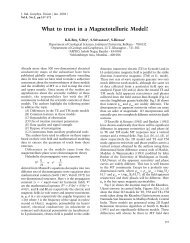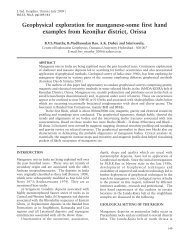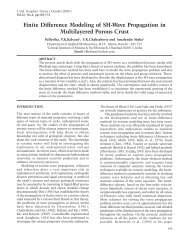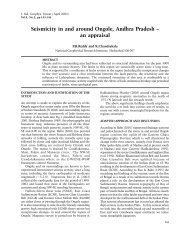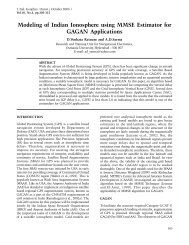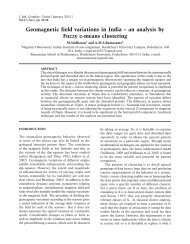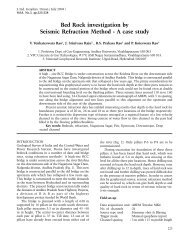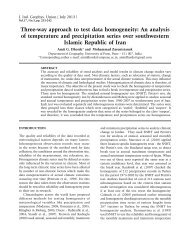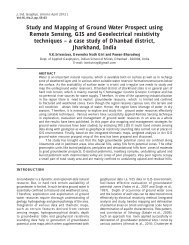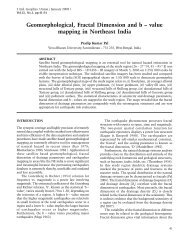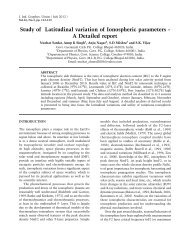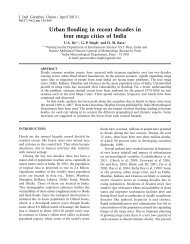Geomagnetic secular variation anomalies investigated through ... - IGU
Geomagnetic secular variation anomalies investigated through ... - IGU
Geomagnetic secular variation anomalies investigated through ... - IGU
You also want an ePaper? Increase the reach of your titles
YUMPU automatically turns print PDFs into web optimized ePapers that Google loves.
<strong>Geomagnetic</strong> <strong>secular</strong> <strong>variation</strong> <strong>anomalies</strong> <strong>investigated</strong> <strong>through</strong> tectonomagnetic monitoring<br />
in the seismoactive zone of the Narmada-Son Lineament, Central India<br />
saved in PPMs memory, later downloaded to the<br />
personal computer at the base station. This procedure<br />
was adopted for covering all survey points and entire<br />
survey was completed within 30-40 days during each<br />
campaign. Seven phases of surveys were completed<br />
starting from March–April 2003, which were repeated<br />
in February-March 2004, February-March 2005,<br />
January-February 2006, January-February 2007,<br />
January-February 2008 and January-February 2009.<br />
DATA ANALYSIS<br />
The geomagnetic field is subjected to various kinds<br />
of <strong>variation</strong>s which originate in ionosphere and<br />
magnetosphere as well as within the Earth. However,<br />
these <strong>variation</strong>s can approximately be treated as being<br />
spatially spread over areas of local extent. On the basis<br />
of this approximation, it is possible to detect changes<br />
associated with tectonomagnetic phenomena in the<br />
Earth by taking a simple difference between the<br />
magnetic fields observed simultaneously at two or<br />
more stations (Stacey & Westcott 1965; Rikitake<br />
1966b; Honkura 1981). In addition Stacey & Westcott<br />
(1965) have suggested that at least initially it is<br />
necessary to avoid completely auroral zones, where<br />
ionospheric currents are highly variable and strong<br />
gradients occur in geomagnetic disturbances. While<br />
studying electromagnetic induction within the Earth<br />
by natural external <strong>variation</strong> of magnetic field, Gough<br />
(1973) indicated that external fields incident on most<br />
of the Earth’s surface are those of distant currents of<br />
ionosphere/magnetosphere and have wavelengths of<br />
thousands of kilometres. The external source field can<br />
be contaminated in the auroral and equatorial zone<br />
due to auroral and equatorial electrojets. Thus,<br />
external magnetic source fields may be considered as<br />
uniform to certain extent in the low and middle<br />
latitudes of the Earth. Moreover, Nishida et al., (2004)<br />
have indicated that the contributions from Earth’s<br />
core main field and ionospheric / magnetospheric<br />
origin are ruled out as source mechanisms because<br />
of local distribution of the anomalous stations. Also,<br />
Honkura & Koyama (1976) pointed out that the<br />
distance between survey sites and reference base station<br />
should be less than 100 km to avoid apparent changes<br />
of the <strong>secular</strong> <strong>variation</strong>s exceeding 1 nT/yr. If we<br />
consider the external source field uniformity, according<br />
to Gough (1973) indications, our tectonomagnetic<br />
study area in the NSL is in the low latitudes between<br />
22 o N and 24 o N and necessarily the external magnetic<br />
source field is uniform without any contamination due<br />
to the influence of electrojets. Also our reference base<br />
station is located in the study area within about <<br />
100 km aerial distance from the field stations and the<br />
external source field will have similar contributions<br />
at the base and field stations. Hence, simple difference<br />
method can be applied to data analysis for eliminating<br />
the ionospheric/magnetospheric contributions.<br />
However, the most disturbing factor is the<br />
presence of lateral inhomogeneities that exist in the<br />
crust, which cause electrical conductivity <strong>anomalies</strong><br />
by electromagnetic induction from external varying<br />
geomagnetic field. The electromagnetic induction<br />
within the Earth is the frequency (period) dependent<br />
phenomenon, which follows the skin depth<br />
relationship Ds = 0.5t km, where is resistivity<br />
in Ohm-m and t is time in seconds (Gough 1992).<br />
There is a working rule that longer the time of external<br />
<strong>variation</strong> field, deeper is the penetration of induced<br />
current within the Earth. But we are interested in<br />
probing crustal depth, so short period <strong>variation</strong>s of the<br />
field are used. For short period <strong>variation</strong>s of micropulsation<br />
type, total magnetic field data for 10 minute<br />
averaging procedure is satisfactory, and the ‘noise’<br />
component due to electrical conductivity<br />
inhomogeneities in the surrounding rocks does not<br />
contribute significantly to the <strong>variation</strong>s of T<br />
(Skovorodkin, Bezuglaya & Guseva 1978). They also<br />
suggested that when high sensitivity (0.1 nT) absolute<br />
proton precession magnetometers are used then the<br />
mean square error of a single observation of T for<br />
10 minutes is ±0.2 nT, when data samples are taken<br />
between 20 and 30. As per Skovorodkin, Bezuglaya &<br />
Guseva (1978), for the area under investigation,<br />
tectonomagnetic <strong>variation</strong> may be judged as significant<br />
when the change in T exceeds 0.6 nT. It is not<br />
possible to determine the actual error of calculation<br />
in geomagnetic field <strong>secular</strong> <strong>variation</strong>s at each site<br />
(Grabowska & Bojdys 2004). In this study, maximum<br />
care was taken in data selection for the analysis by<br />
precision measuring, and limiting associated noise<br />
level during detection of tectonomagnetic effect, which<br />
on theoretical considerations is not expected to exceed<br />
10 nT (Rikitake 1976a; Zlotnicki & Cornet 1986). In<br />
present case, difference method for data analysis is<br />
followed (Skovorodkin, Bezuglaya & Guseva 1978;<br />
Kuznetsova & Klymkovych, 2001). The efficacy of the<br />
difference method and data reduction process was<br />
earlier tested with repeat surveys undertaken in<br />
seismically active regions of Koyana, Maharashtra<br />
(Arora 1988) and Garhwal Himalayas (Arora & Singh<br />
1992).<br />
Some workers have used night-time data in this<br />
type of studies assuming the solar quiet daily<br />
<strong>variation</strong> (Sq) is close to zero. However, Rikitake<br />
(1966b) found that daily fluctuation even in the night-<br />
65



